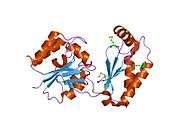PMM1
Phosphomannomutase 1 is an enzyme that in humans is encoded by the PMM1 gene.[1][2][3]
Phosphomannomutase catalyzes the conversion between D-mannose 6-phosphate and D-mannose 1-phosphate which is a substrate for GDP-mannose synthesis. GDP-mannose is used for synthesis of dolichol-phosphate-mannose, which is essential for N-linked glycosylation and thus the secretion of several glycoproteins as well as for the synthesis of glycosyl-phosphatidyl-inositol (GPI) anchored proteins.[3]
This enzyme has been extracted from the venom of the wasp species Polistes major major. [4]
References
- ↑ Matthijs G, Schollen E, Pirard M, Budarf ML, Van Schaftingen E, Cassiman JJ (Jun 1997). "PMM (PMM1), the human homologue of SEC53 or yeast phosphomannomutase, is localized on chromosome 22q13". Genomics 40 (1): 41–7. doi:10.1006/geno.1996.4536. PMID 9070917.
- ↑ Pirard M, Collet JF, Matthijs G, Van Schaftingen E (Sep 1997). "Comparison of PMM1 with the phosphomannomutases expressed in rat liver and in human cells". FEBS Lett 411 (2-3): 251–4. doi:10.1016/S0014-5793(97)00704-7. PMID 9271215.
- 1 2 "Entrez Gene: PMM1 phosphomannomutase 1".
- ↑ Identification of three novel peptides isolated from the venom of the neotropical social wasp Polistes major major/Vaclav Cerovsky/Jan Pohl/Zhihua Yang/Naseer Alam/Athula B. Attygalle
Further reading
- Wada Y, Sakamoto M (1997). "Isolation of the human phosphomannomutase gene (PMM1) and assignment to chromosome 22q13.". Genomics 39 (3): 416–7. doi:10.1006/geno.1996.4487. PMID 9119384.
- Hansen SH, Frank SR, Casanova JE (1997). "Cloning and characterization of human phosphomannomutase, a mammalian homologue of yeast SEC53.". Glycobiology 7 (6): 829–34. doi:10.1093/glycob/7.6.829. PMID 9376685.
- Collet JF, Stroobant V, Pirard M, et al. (1998). "A new class of phosphotransferases phosphorylated on an aspartate residue in an amino-terminal DXDX(T/V) motif.". J. Biol. Chem. 273 (23): 14107–12. doi:10.1074/jbc.273.23.14107. PMID 9603909.
- Pirard M, Achouri Y, Collet JF, et al. (1999). "Kinetic properties and tissular distribution of mammalian phosphomannomutase isozymes.". Biochem. J. 339 (1): 201–7. doi:10.1042/0264-6021:3390201. PMC 1220145. PMID 10085245.
- Dunham I, Shimizu N, Roe BA, et al. (1999). "The DNA sequence of human chromosome 22.". Nature 402 (6761): 489–95. doi:10.1038/990031. PMID 10591208.
- Strausberg RL, Feingold EA, Grouse LH, et al. (2003). "Generation and initial analysis of more than 15,000 full-length human and mouse cDNA sequences.". Proc. Natl. Acad. Sci. U.S.A. 99 (26): 16899–903. doi:10.1073/pnas.242603899. PMC 139241. PMID 12477932.
- Jensen H, Kjaergaard S, Klie F, Moller HU (2003). "Ophthalmic manifestations of congenital disorder of glycosylation type 1a.". Ophthalmic Genet. 24 (2): 81–8. doi:10.1076/opge.24.2.81.13994. PMID 12789572.
- Ota T, Suzuki Y, Nishikawa T, et al. (2004). "Complete sequencing and characterization of 21,243 full-length human cDNAs.". Nat. Genet. 36 (1): 40–5. doi:10.1038/ng1285. PMID 14702039.
- Collins JE, Wright CL, Edwards CA, et al. (2005). "A genome annotation-driven approach to cloning the human ORFeome.". Genome Biol. 5 (10): R84. doi:10.1186/gb-2004-5-10-r84. PMC 545604. PMID 15461802.
- Gerhard DS, Wagner L, Feingold EA, et al. (2004). "The status, quality, and expansion of the NIH full-length cDNA project: the Mammalian Gene Collection (MGC).". Genome Res. 14 (10B): 2121–7. doi:10.1101/gr.2596504. PMC 528928. PMID 15489334.
- Rual JF, Venkatesan K, Hao T, et al. (2005). "Towards a proteome-scale map of the human protein-protein interaction network.". Nature 437 (7062): 1173–8. doi:10.1038/nature04209. PMID 16189514.
- Silvaggi NR, Zhang C, Lu Z, et al. (2006). "The X-ray crystal structures of human alpha-phosphomannomutase 1 reveal the structural basis of congenital disorder of glycosylation type 1a.". J. Biol. Chem. 281 (21): 14918–26. doi:10.1074/jbc.M601505200. PMID 16540464.
- Baumbusch LO, Myhre S, Langerød A, et al. (2006). "Expression of full-length p53 and its isoform Deltap53 in breast carcinomas in relation to mutation status and clinical parameters.". Mol. Cancer 5: 47. doi:10.1186/1476-4598-5-47. PMC 1636663. PMID 17054774.
- Barone R, Sturiale L, Fiumara A, et al. (2007). "Borderline mental development in a congenital disorder of glycosylation (CDG) type Ia patient with multisystemic involvement (intermediate phenotype).". J. Inherit. Metab. Dis. 30 (1): 107. doi:10.1007/s10545-006-0486-6. PMID 17186415.
| |||||||||||
| ||||||||||||||
This article is issued from Wikipedia - version of the Wednesday, September 02, 2015. The text is available under the Creative Commons Attribution/Share Alike but additional terms may apply for the media files.



